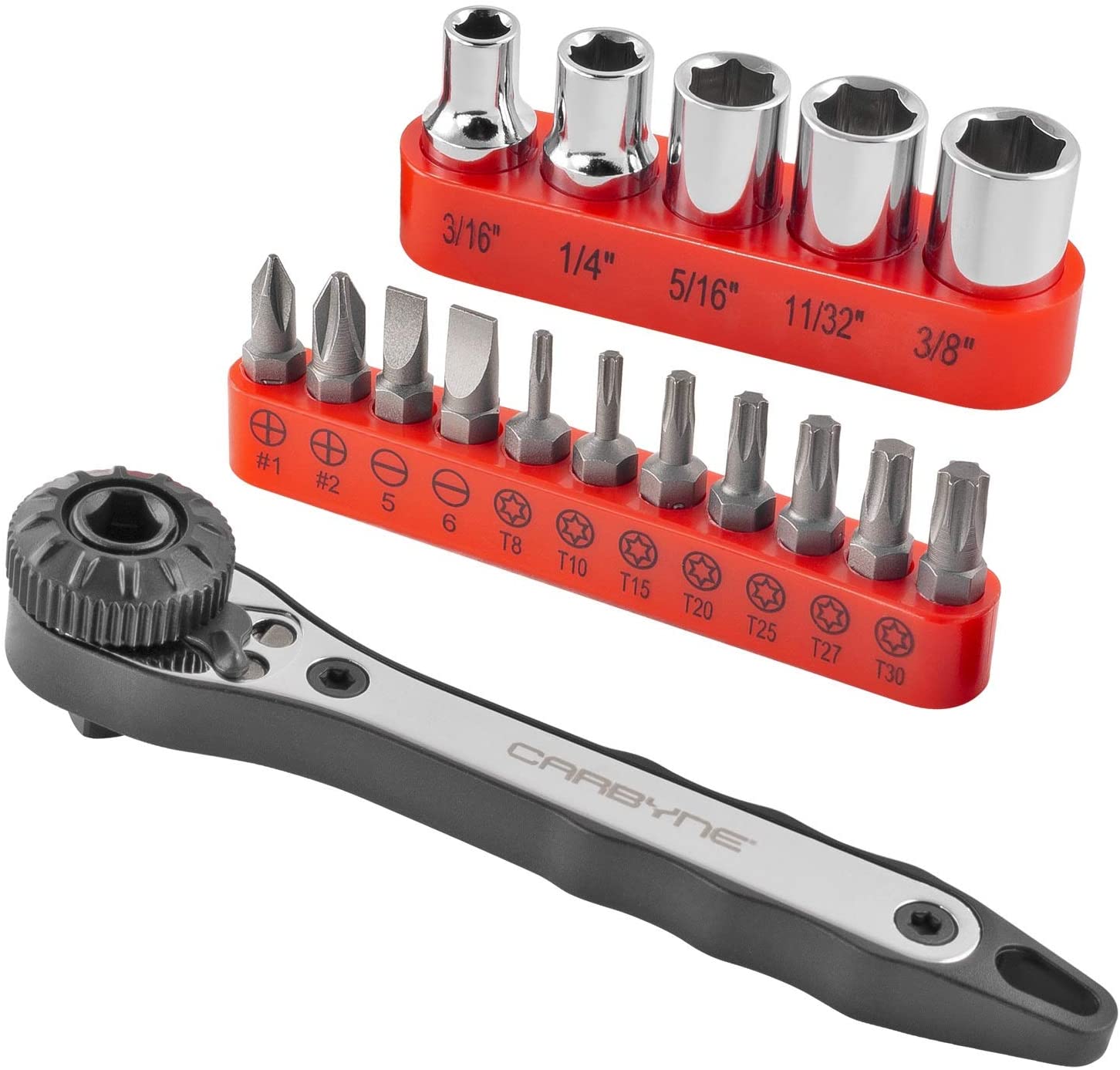Ratchet Screwdriver vs Wrench
A ratchet screwdriver has a hole where you can insert screwdriver specific bits. You insert the bits which are held in place either through magnetism or some mechanical form of retention. This is different from a ratchet wrench where instead of a hole there is a square post (known as a "tang") that sockets with matching holes plug into.
Ratchet screwdrivers are usually used on screws. Ratchet wrenches are usually used on nuts and bolts. But with the right bit and / or adapter either tool can be used for either purpose.
You can also buy tools that are a combination of both. One side has a hole for screwdriver bits. The other side has a tang. I list the one I own below.
The ratchet is so that you don't have to keep letting go of the handle and readjusting your grip to keep turning. It usually has a latch so that you can reverse the direction of which way it turns.
You can also buy cordless screwdrivers that do a lot of the work for you.
Where to Buy
- GreaTalent 54in1 S2 Steel Mini Ratchet Wrench Screwdriver Bit Set with 1/4" Hex Shank Bits, 1/4" Drive Socket, Socket Adapter, Extension Bit Holder, 36-Tooth Gear - a nice kit similar to iFixit kits, but with a right angle ratchet screwdriver with magnetic retention
- CARBYNE 17 Piece Right Angle Mini Ratchet Wrench Screwdriver, 1/4 Inch Dual-Drive Head | Bit Set & Sockets | CR-V Steel - this is a nice starter kit that I own which can handle both bits and sockets - I use it when I need more torque
- DEWALT DCF682N1 8V MAX Gyroscopic Inline Screwdriver with DEWALT DW2166 45 Piece Screwdriving Set with Tough Case - this cordless screwdriver set comes with a lot of bits
- Standard Multi-Bit 15-Piece Ratcheting Screwdriver - a traditional shaped ratcheting screwdriver that comes with both bits and sockets stored in the handle
- DOUBLEDRIVE 32 Pc 2X Speed Dual Ratcheting Screw Driver with Multi Bits, Magnetic Screwdriver and Socket Set with T-handle - a T-handle ratchet set that can be a bit more comfortable to use
- Magid TB725EPP Top Gunn Double Layer Split Leather Palm Work Glove with Safety Cuff, Work, Large, Tan (Case of 12) - these look like the work gloves that I own
Handles, T-Handles and Torque
Ratchet screwdrivers generally come in one of these forms:
- Looks more like a traditional screwdriver
- Right angle - looks like a wrench with a handle to provide more torque
- Has a T-handle, usually padded for comfort
In many cases I find the more traditional screwdriver form works just fine. But sometimes when taking something apart I find I can't get enough torque out of a screwdriver shaped ratchet. In that case I have to resort to a right angle ratchet screwdriver to get the turning power that I need.
I do find that some metal right angle ratchet handles can be a pain to grip on large jobs. In such a case you may find a T-handle ratchet screwdriver provides a combination of torque and comfort. This is also why in many product photos you see people wearing work gloves.
Ratchet vs Nut Driver
When you buy a screwdriver shaped ratchet screwdriver make sure that it has a ratchet and is not what is called a nut driver. Usually when a product is called a nut driver that means it has no ratchet and you have to just turn it like a regular screwdriver.
Ratchet Teeth Count
You will see some ratchet tools rated by their tooth count. Let's say you have a ratchet with 36 teeth. If you divide 360 degrees by 36 that means you have 10 degrees between each tooth. That means that as you ratchet back and forth you have to swing the handle 10 degrees before it will catch the next tooth to continue turning.
Many right angle ratchet tools come with 36 teeth which I find just fine. But you will also see options going as high as 72 teeth, which means you will only need to turn 5 degrees. I find I swing back more than 10 degrees each turn so it usually doesn't matter. But it could make a difference when reaching far into the tight quarters of say the engine bay on a car.
Bit Storage
I keep a lot of my tools in a tool drawer and various toolboxes. So I never worry too much about losing bits. But I do find it easy to organize and travel with my tools when they the come with some form of bit and socket storage. So you should look for tools with the following:
- Comes in a latching kit where bits and sockets are clearly labeled and have slots in the case for storage (make sure the latch is strong or your bits will end up scattered all over the place)
- Has storage for the bits in the handle (more common then you would think)
- Has clearly labeled strips with slots for each bit and / or socket
Related Articles

